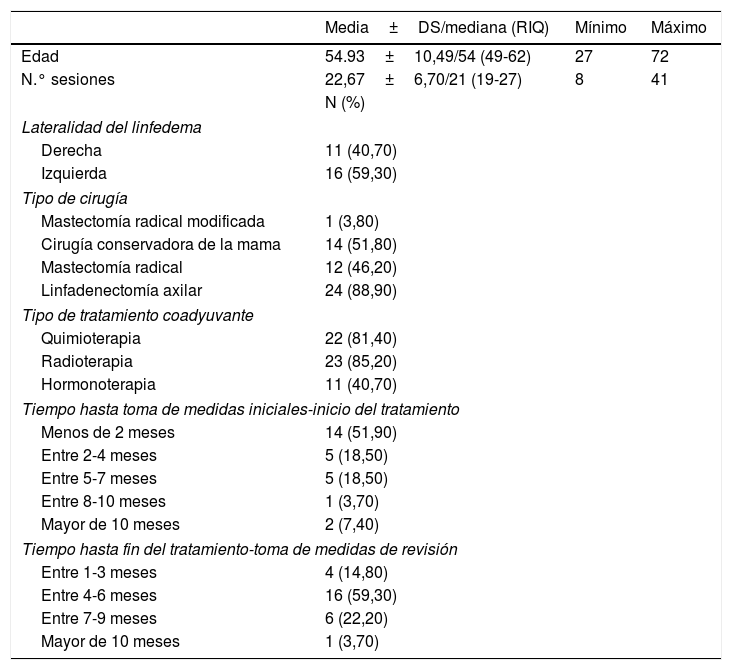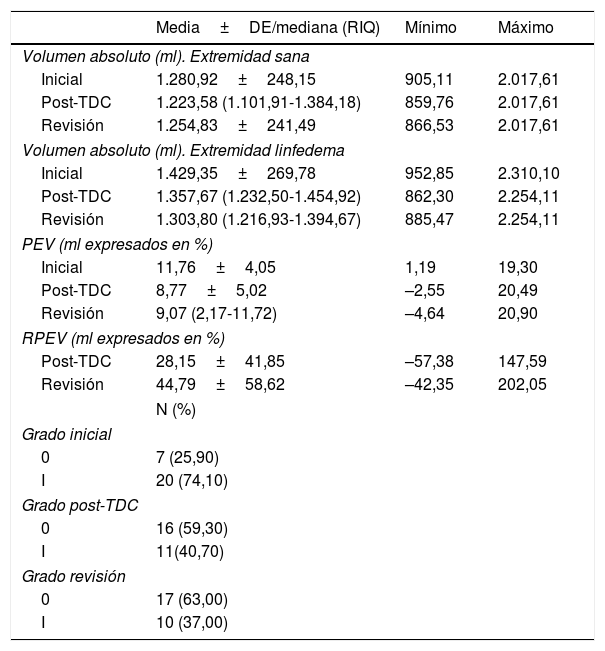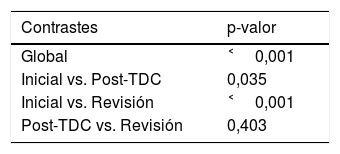Analizar los resultados del tratamiento con terapia descongestiva compleja (TDC) aplicada por primera vez en sujetos con linfedema secundario a cáncer de mama (LSCM) grados 0-I.
Material y métodosEstudio descriptivo retrospectivo con sujetos diagnosticados de LSCM de grado 0 y I en una Unidad de Linfedema, a los que se les realiza TDC por primera vez entre los años 2013 y 2016. Se compara el porcentaje de exceso de volumen (PEV) del linfedema en 3 intervalos (inicial, postratamiento y en la revisión médica) y se calcula la reducción del mismo (RPEV) después del tratamiento. Se registran datos demográficos, clínicos y las características del linfedema.
ResultadosFueron incluidas 27 mujeres, con una media de edad de 55 años (49-62). El 88,90% de ellas (n=24) intervenidas de linfadenectomía y el 85,20% (n=23) con radioterapia coadyuvante. Se realizaron de media de 23 sesiones. Previo a la TDC 7 participantes tenían LSCM de grado 0 y 20 de grado I; después del tratamiento 16 participantes tenían linfedema de grado 0 y 11 de grado I. La media inicial de PEV fue de 11,76%, 8,77% después del tratamiento y 7,57% en la revisión médica. El PEV se redujo en 22 participantes después del tratamiento (81,50%). Exceptuando un caso, la reducción de volumen se mantuvo estable en la revisión médica. La RPEV después del tratamiento fue 28,15% y 44,79% en la revisión médica.
ConclusiónEste estudio muestra unos resultados favorables al empleo de TDC para el tratamiento de linfedema secundario a cáncer de mama de grado 0 y/o I.
To analyse the outcomes of Complex Decongestive Therapy (CDT) applied for the first time in patients with Breast Cancer-Related Lymphoedema (BCRL) stages 0-I.
Material and methodsA descriptive and retrospective study performed on subjects with BCRL severity stages 0 and I recruited in the Lymphology Unit, and who had CDT for the first time between 2013 and 2016. A comparison was made of the percent excess volume (PEV) of lymphoedema at 3 intervals (initial, post-treatment, and medical check-up) and we calculated the percent excess volume reduction (PEVR) after treatment. Demographic data, clinical and lymphoedema characteristics were recorded.
ResultsThe study included a total of 27 women, with mean age of 55 years (49-62). A lymphadenectomy had been performed on 88.90% (n=24), and 85.20% (n=23) had radiation therapy. There was a mean of 23 sessions. Before CDT, 7 participants had stage 0 BCRL and 20 had stage I. After treatment, 16 participants had lymphoedema stage 0 and 11 had stage I. The mean initial PEV was 11.76%, 8.77% after treatment and 7.57% in the medical check-up. PEV was reduced in 22 participants after treatment (81.50%). There was only one case where the reduction of volume remained stable in the medical check-up. The mean PEVR after treatment was 28.15% and 44.79% in the medical check-up.
ConclusionThis study shows favourable results of Complex Decongestive Therapy in Breast Cancer-Related Lymphoedema stages 0 and I.
Artículo
Si ya tiene sus datos de acceso, clique aquí.
Si olvidó su clave de acceso puede recuperarla clicando aquí y seleccionando la opción "He olvidado mi contraseña".Comprando el artículo el PDF del mismo podrá ser descargado
Precio 19,34 €
Comprar ahora











